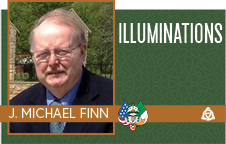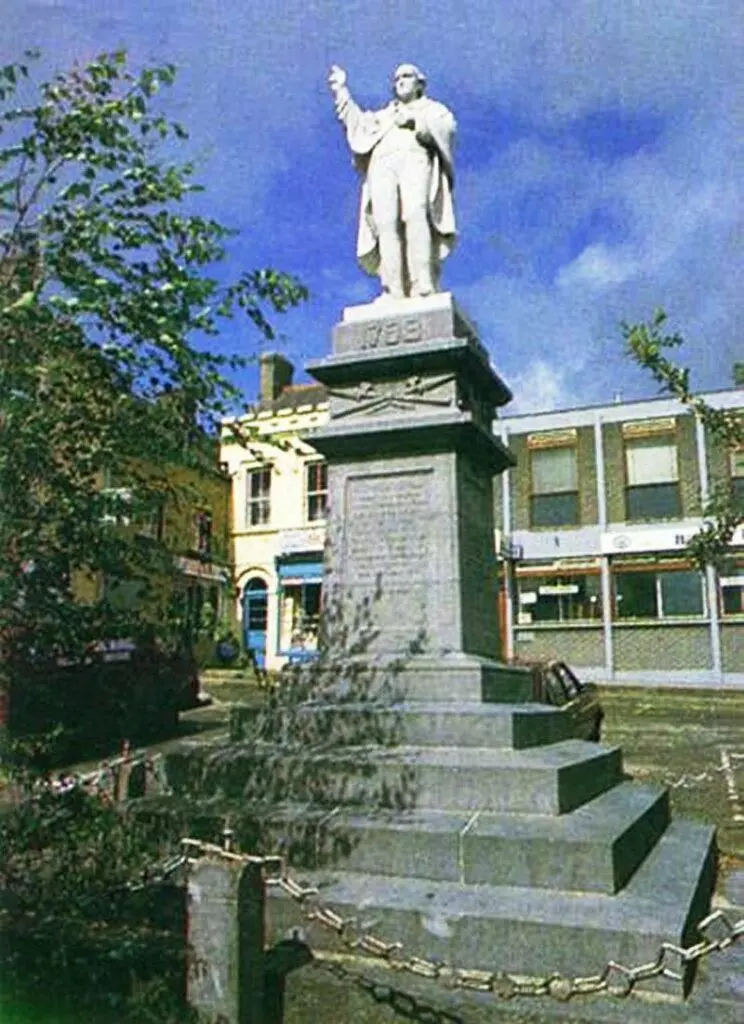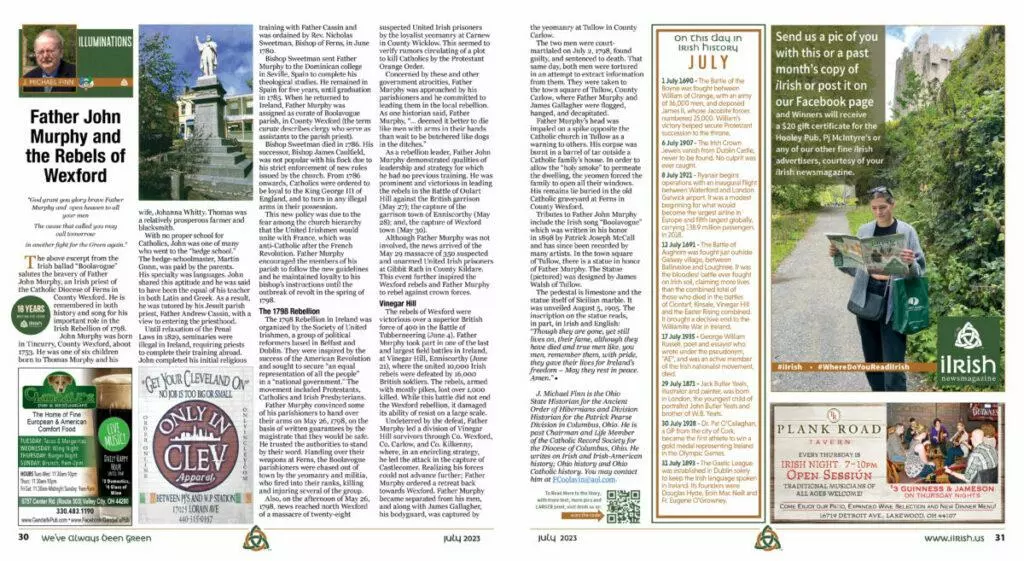
By J. Michael Finn
June 28, 2023
“God grant you glory brave Father Murphy and
open heaven to all your men
The cause that called you may call tomorrow
in another fight for the Green again.”

The above excerpt from the Irish ballad “Boolavogue” salutes the bravery of Father John Murphy, an Irish priest of the Catholic Diocese of Ferns in County Wexford.
He is remembered in both history and song for his important role in the Irish Rebellion of 1798.
John Murphy was born in Tincurry, County Wexford, about 1753. He was one of six children born to Thomas Murphy and his wife, Johanna Whitty. Thomas was a relatively prosperous farmer and blacksmith.
With no proper school for Catholics, John was one of many who went to the “hedge school.” The hedge-schoolmaster, Martin Gunn, was paid by the parents. His specialty was languages. John shared this aptitude and he was said to have been the equal of his teacher in both Latin and Greek. As a result, he was tutored by his Jesuit parish priest, Father Andrew Cassin, with a view to entering the priesthood.
Until relaxation of the Penal Laws in 1829, seminaries were illegal in Ireland, requiring priests to complete their training abroad. John completed his initial religious training with Father Cassin and was ordained by Rev. Nicholas Sweetman, Bishop of Ferns, in June 1780.
Bishop Sweetman sent Father Murphy to the Dominican college in Seville, Spain to complete his theological studies. He remained in Spain for five years, until graduation in 1785. When he returned to Ireland, Father Murphy was assigned as curate of Boolavogue parish, in County Wexford (the term curate describes clergy who serve as assistants to the parish priest).
Bishop Sweetman died in 1786. His successor, Bishop James Caulfield, was not popular with his flock due to his strict enforcement of new rules issued by the church. From 1786 onwards, Catholics were ordered to be loyal to the King George III of England, and to turn in any illegal arms in their possession.
This new policy was due to the fear among the church hierarchy that the United Irishmen would unite with France, which was anti-Catholic after the French Revolution. Father Murphy encouraged the members of his parish to follow the new guidelines and he maintained loyalty to his bishop’s instructions until the outbreak of revolt in the spring of 1798.
The 1798 Rebellion
The 1798 Rebellion in Ireland was organized by the Society of United Irishmen, a group of political reformers based in Belfast and Dublin. They were inspired by the success of the American Revolution and sought to secure “an equal representation of all the people” in a “national government.” The movement included Protestants, Catholics and Irish Presbyterians.
Father Murphy convinced some of his parishioners to hand over their arms on May 26, 1798, on the basis of written guarantees by the magistrate that they would be safe. He trusted the authorities to stand by their word. Handing over their weapons at Ferns, the Boolavogue parishioners were chased out of town by the yeomanry and militia, who fired into their ranks, killing and injuring several of the group.
Also, on the afternoon of May 26, 1798, news reached north Wexford of a massacre of twenty-eight suspected United Irish prisoners by the loyalist yeomanry at Carnew in County Wicklow. This seemed to verify rumors circulating of a plot to kill Catholics by the Protestant Orange Order.
Concerned by these and other government atrocities, Father Murphy was approached by his parishioners and he committed to leading them in the local rebellion. As one historian said, Father Murphy, “… deemed it better to die like men with arms in their hands than wait to be butchered like dogs in the ditches.”
As a rebellion leader, Father John Murphy demonstrated qualities of leadership and strategy for which he had no previous training. He was prominent and victorious in leading the rebels in the Battle of Oulart Hill against the British garrison (May 27); the capture of the garrison town of Enniscorthy (May 28); and, the capture of Wexford town (May 30).
Although Father Murphy was not involved, the news arrived of the May 29 massacre of 350 suspected and unarmed United Irish prisoners at Gibbit Rath in County Kildare. This event further inspired the Wexford rebels and Father Murphy to rebel against crown forces.
Vinegar Hill
The rebels of Wexford were victorious over a superior British force of 400 in the Battle of Tubberneering (June 4). Father Murphy took part in one of the last and largest field battles in Ireland, at Vinegar Hill, Enniscorthy (June 21), where the united 10,000 Irish rebels were defeated by 16,000 British soldiers. The rebels, armed with mostly pikes, lost over 1,000 killed. While this battle did not end the Wexford rebellion, it damaged its ability of resist on a large scale.
Undeterred by the defeat, Father Murphy led a division of Vinegar Hill survivors through Co. Wexford, Co. Carlow, and Co. Kilkenny, where, in an encircling strategy, he led the attack in the capture of Castlecomer. Realizing his forces could not advance further; Father Murphy ordered a retreat back towards Wexford. Father Murphy became separated from his men, and along with James Gallagher, his bodyguard, was captured by the yeomanry at Tullow in County Carlow.
The two men were court-martialed on July 2, 1798, found guilty, and sentenced to death. That same day, both men were tortured in an attempt to extract information from them. They were taken to the town square of Tullow, County Carlow, where Father Murphy and James Gallagher were flogged, hanged, and decapitated.
Father Murphy’s head was impaled on a spike opposite the Catholic church in Tullow as a warning to others. His corpse was burnt in a barrel of tar outside a Catholic family’s house. In order to allow the “holy smoke” to permeate the dwelling, the yeomen forced the family to open all their windows. His remains lie buried in the old Catholic graveyard at Ferns in County Wexford.
Tributes to Father John Murphy include the Irish song “Boolavogue” which was written in his honor in 1898 by Patrick Joseph McCall and has since been recorded by many artists. In the town square of Tullow, there is a statue in honor of Father Murphy. The Statue (pictured) was designed by James Walsh of Tullow.
The pedestal is limestone and the statue itself of Sicilian marble. It was unveiled August 5, 1905. The inscription on the statue reads, in part, in Irish and English:
“Though they are gone, yet still lives on, their fame, although they have died and true men like, you men, remember them, with pride, they gave their lives for Ireland’s freedom – May they rest in peace. Amen.”

- This Just In: MICHIGAN IRISH AMERICAN HALL OF FAME NAMES 2024 MEMBERS
- This Just In: Pittsburgh Day of Irish Entertainment is Coming
- This Just In: A week is still a long time in politics
- This Just In: Recognition of Palestinian Statehood an important step for the Palestinian people – Mary Lou McDonald TD
- This Just In: Update on Bringing National Women’s Soccer League to Cleveland

*J. Michael Finn is the Ohio State Historian for the Ancient Order of Hibernians and Division Historian for the Patrick Pearse Division in Columbus, Ohio. He is also past Chairman and Life Member of the Catholic Record Society for the Diocese of Columbus, Ohio. He writes on Irish and Irish-American history; Ohio history and Ohio Catholic history. You may contact him at [email protected].





